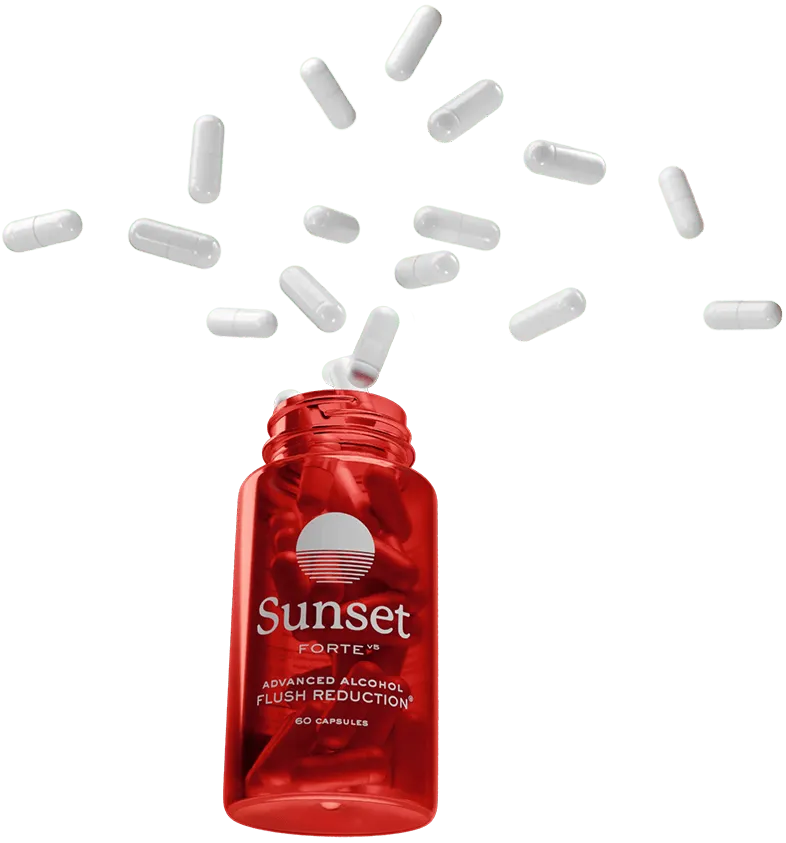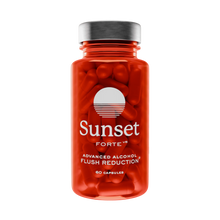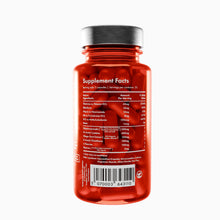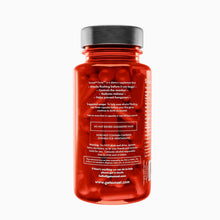What is Asian Glow? The Complete Guide to Asian Flush Reaction

⏱️ TL:DR ∙ Article in 20s
Alcohol Flush Reaction', also known as Asian Flush or Glow, is a common condition affecting over a third of East Asians, causing facial flushing, nausea, headaches, and other unpleasant symptoms after drinking due to an enzyme deficiency. While genetic, its effects can be minimized through strategic drink choices, intelligent makeup choices to hide facial redness, and most effectively, by taking supplements designed to provide relief from flushing symptoms, allowing social drinking without discomfort.
- The science behind Asian Glow
- Signs and symptoms
- Causes of Asian Flush
- How to identify Asian Flush
- DIY alcohol flush cures
- Preventing Asian Flush
Share this article
Copy and paste this link
If your face turns red and flushes after drinking alcohol, you're not alone. This common reaction is known as "asian flush" or "alcohol flush reaction" and affects many people of East Asian descent.
The good news is, while having asian glow can be unpleasant and embarrassing in social situations, there are ways to prevent and treat it. In this article, we'll explain exactly what causes the asian red face glow.
Specifically, we'll cover the underlying genetics, how drinking leads to facial flushing and other symptoms. Our goal is to educate on the science behind asian flush and demystify what is a relatively understudied topic.
What Is Asian Glow: Meaning & the Science Behind Alcohol Flushing
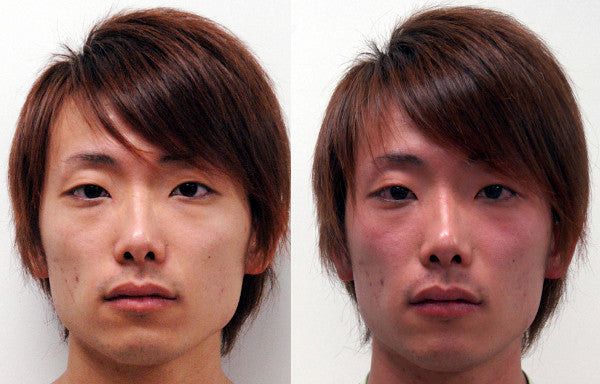
While you may hear it referred to as Asian flush or glow, the more scientific term is alcohol flush reaction.
This refers to when a person becomes red in the face, neck, and upper body after consuming alcohol. This happens because of an accumulation of acetaldehyde, a toxin that is produced when the body metabolizes alcohol.
Regular consumers of alcohol have an enzyme that breaks down these toxins into a harmless substance that is easily processed by the body.
However, some people are deficient in this important enzyme and much less able to break down these toxins. When these people drink alcohol, the toxins accumulate and end up causing the reaction known as Asian flush.
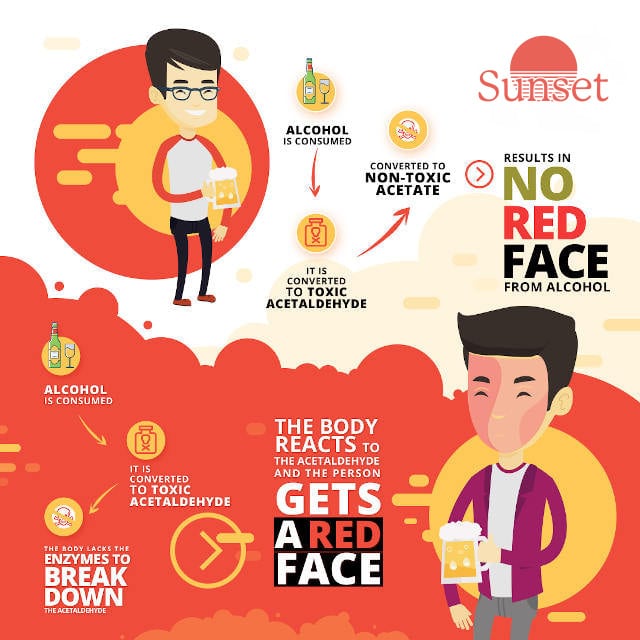
Whilst the red face after drinking alcohol is the most common sign of this condition, there are several other unpleasant symptoms that go along with it. These include shortness of breath after drinking alcohol, nasal congestion after drinking alcohol, nausea from alcohol, and more.
According to Amitava Dasgupta, PhD and professor at The University of Texas Health Science Center, the effects are often so uncomfortable that people with this condition may stop drinking altogether. You can learn more about how to remove acetaldehyde from body naturally in our complete guide. We also have a full article explaining aldh2 deficiency symptoms.
Signs And Symptoms Of Asian Flush
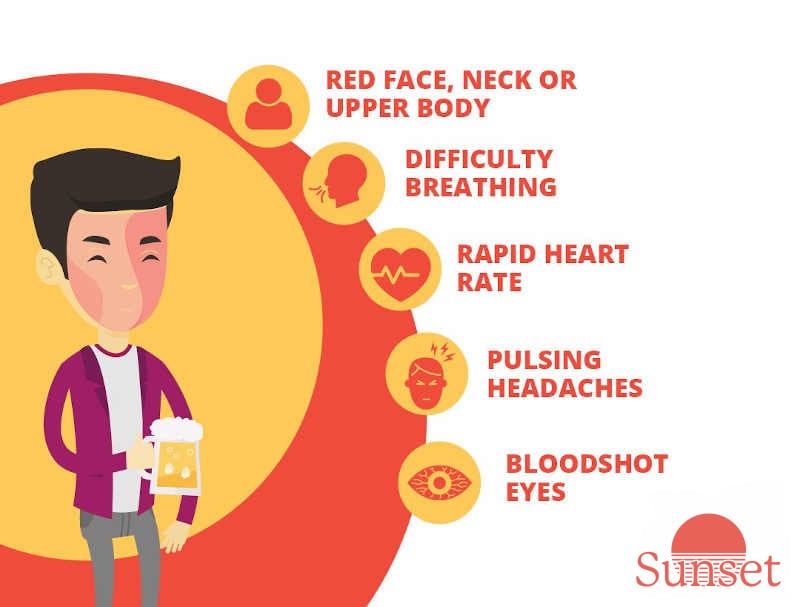
As mentioned earlier, alcohol flush reaction carries a myriad of symptoms other than flushing. Here are some of the most noteworthy:
- Redness of the upper body and other areas of the body (such as neck, chest and shoulders)
- Swelling of the cheeks
- Sensation of warmth and itchiness
- Red eyes
- Increased heart rate
- Difficulty breathing and/or restricted breathing
- Headaches
- Nausea
- A general sense of upper body pressure
- Dizziness
- Nasal congestion
The results of a 2019 survey of people with Asian Flush showed that red facial flushing is the most common symptom, with headaches coming in a clear second.
Nearly 100% of people who were surveyed reported that they experience flushing after alcohol (in addition to other, lesser symptoms).

While these symptoms sound similar to a hangover, this condition arises between 20 to 40 minutes after consuming alcohol. Those with severe alcohol flush syndrome may even experience symptoms after just a few sips of alcohol.
Sufferers also report that these symptoms can last up to a day or two, making drinking alcohol an uncomfortable and drawn-out activity.
Why do people get the Asian flush?
The underlying cause of this condition is genetic and, as the name suggests, most prevalent among those of East Asian descent. However, ALDH2 deficiency in Caucasians is more common than you may think. That's why it has also been referred to as an 'alcohol flush reaction', since it doesn't just affect Asians.
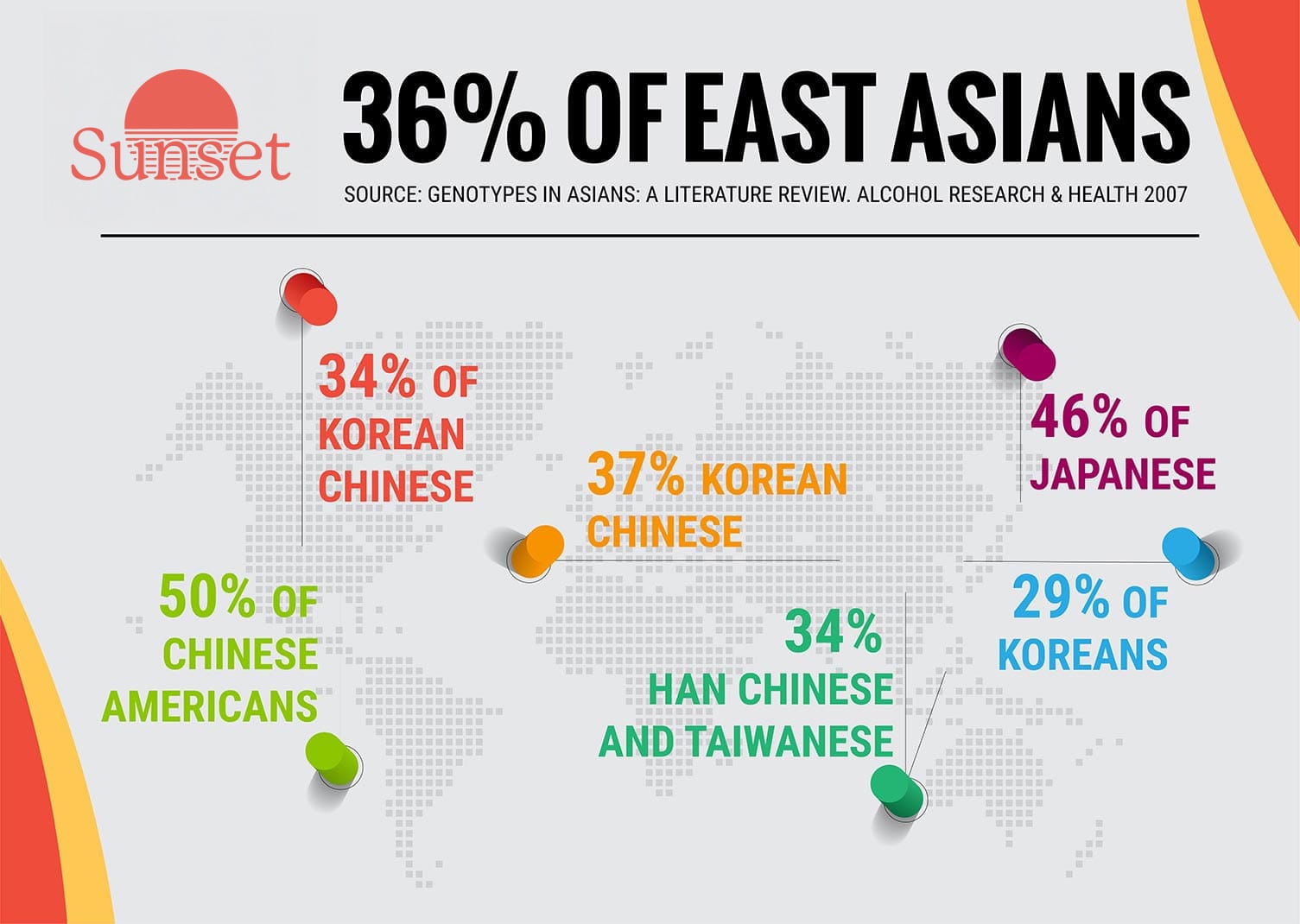
The cause of this condition is genetic and, as the name suggests, most prevalent among those of East Asian descent. It has also been referred to as an 'alcohol flush reaction'.
According to a literature review by scientists at the University of California, this condition is experienced by:
- 34% of Korean Americans
- 50% of Chinese Americans
- 29% of Koreans
- 37% of Korean Chinese
- 46% of Japanese
- 34% of Han Chinese and Taiwanese
The review highlights two main genetic factors that cause Asian flush:
- 80% of East Asian populations convert ethanol to acetaldehyde faster than normal.
- 30% to 50% of East Asians can't break down that acetaldehyde normally.
These factors combined explain the prevalence of Asian flush among the Asian population.
To get a bit scientific, this condition is the result of a lack of aldehyde dehydrogenase 2 (ALDH2) enzymes - responsible for helping break down ethanol in the liver.
Other Asian Flush Causes Aside From Alcohol
From medications, dietary choices, and even unrelated medical conditions, there are lots of other causes of red face - so let's take a look at a few.
Certain Medication May Cause Similar Symptoms To Asian Flush
Red flushes can be caused by various medications, which doesn’t necessarily mean that it’s due to an allergic reaction.
Opioids, like oxycodone, as well as doxorubicin and Viagra, are reported to induce the Asian flush-like redness in a fraction of patients who medicate themselves with these drugs.
The cause for this skin reaction is uncertain, so if you experience red flushes after using some of the previously-mentioned medication, make sure to consult with your doctor to see if there is a suitable alternative.
Cushing Syndrome
The steroid hormone cortisol, also known as the “stress hormone”, serves us by keeping our immune system in check, regulating our blood sugar, managing our blood pressure, turning food into energy, and reducing inflammation.
When this hormone’s levels are too high, many negative consequences can occur, red flushing being one of them. This results in the condition known as the Cushing syndrome, which can also occur due to excessive use of cortisol-like drugs, also known as steroids.
Spicy Foods
Certain spicy foods can be a trigger enough for the appearance of the glow-like redness on your face and neck, especially if you don’t consume these kinds of foods that often and/or if you have fair skin.
This occurs due to increased blood flow, which causes dilation of the facial blood vessels, hence more blood flow rises to the surface of the skin, making it flush.
Emotional Triggers
Emotions can be very tricky and quite often are the cause of some involuntary reactions, excessive blushing being one of them.
Anxiety is a very common trigger of turning one’s face red while speeding up the heart rate and breathing.
Anxiety attacks are not something to be taken lightly, so if this is the cause of your red flushes, talk to your doctor about some strategies which can help you overcome this frequent mood disorder.
What it's like to get Asian Flush
How do you know if you're suffering from Asian glow or something else, such as sudden alcohol intolerance or an allergic reaction to liquor?
We asked a member of the SRQ Labs team, what it felt like when he experienced this condition:
“I remember the first time my face went red from alcohol. It was about 15 years ago and I was at a house party trying to get the interest of a girl.
The night was progressing pretty well. We were chatting and all signs were pointing in a positive direction. That was until she offered me a beer. A simple, innocent, cold, refreshing beer.
I downed it with manly gusto, trying to hide the fact that I’d never drunk a full bottle of beer before. Little did I know, this would start a 20-minute countdown to me becoming the focus of the room for all the wrong reasons.
It didn’t take long before I began to feel the skin on my face heating up and beginning to tingle. Not long after that, it became harder to breathe and I could feel my eyes becoming bloodshot.
I could tell something was wrong by the concerned look on the girl's face. Then I heard a voice from across the room yell out 'Look how smashed he is!'.
At this point everyone’s eyes were on me, my face was pulsating and quickly becoming the center of everyone’s attention. 'Are you on drugs?' she asked as she distanced herself from the laughing stock of the room.”
Final Thoughts on Asian Glow Alcohol Flush Reaction
That concludes our complete guide on the Asian glow meaning. Hopefully, you have a better understanding of the relationship between alcohol intake and facial flushing after reading this article. If not, explore our blog for more great resources - such as how long does flushing last or the alcohol flush reaction cancer risk.
Enjoy drinking again and get Sunset Alcohol Flush Support for
33% off while stocks last!
What’s inside?
We use a pharmacist-formulated blend of Glutathione, Dihydromyricetin, Cysteine, L-Theanine, & B Vitamins to stop alcohol flushing before it can begin.
Learn more
94% of people who try Sunset are satisfied with the results.
